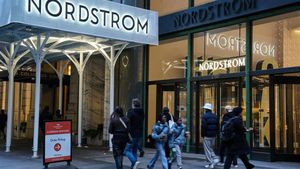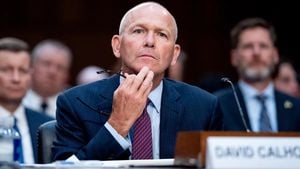The future of two NASA astronauts, Butch Wilmore and Suni Williams, currently aboard the International Space Station (ISS), hangs precariously as NASA wrestles with the decision of how best to bring them home. Originally scheduled for what was supposed to be a weeklong mission, these astronauts have found themselves unexpectedly stuck in orbit for nearly 80 days due to serious complications with Boeing's Starliner spacecraft. This tension-filled situation highlights the many hurdles Boeing has faced with its crewed spacecraft development and raises questions about alternatives, including SpaceX's Crew Dragon.
NASA is poised to make this pivotal decision at an official review, planned for Saturday, aimed at assessing the safety of Starliner for the astronauts' return. A news conference following the review will provide updates and potentially clarify the astronauts' future, but delays have been common. With so much riding on the outcome, anticipation is palpable.
Boeing's Starliner mission has not been without its issues. Shortly before Wilmore and Williams launched on June 5, the spacecraft experienced a helium leak within its propulsion system. Although this was deemed manageable at the time, things took another turn for the worse once it reached the International Space Station. After reaching orbit, it faced not just one, but multiple thruster failures, with five of the 28 reactive thrust engines failing during testing. Despite these failures, the capsule managed to dock with the ISS, but the continued uncertainty surrounding its thrusters has caused significant concern among NASA officials.
NASA has emphasized the astronauts are not truly stranded. Wilmore and Williams have access to all necessary supplies aboard the ISS, including plenty of food and equipment for scientific research. Still, there’s no doubt the situation presents unique challenges. They've been assured they can utilize Starliner as a lifeboat if needed, and it's important to note they were extra prepared — the Starliner’s docking capabilities would allow for safe emergency departures. Of course, having those options isn’t exactly comforting for the astronauts, who had anticipated returning sooner.
If SpaceX's Crew Dragon becomes the method of return for Wilmore and Williams, their stay could extend even longer, possibly pushing their return until February 2025. This rearrangement would involve bumping two current Crew-9 astronauts from their mission so as to accommodate the two NASA astronauts. Part of the intent behind creating redundancy with NASA's contract of two separate commercial spacecraft was precisely to tackle these kinds of dilemmas: if one capsule faced issues, the other could help rescue astronauts.
SpaceX's Crew Dragon has successfully flown multiple crewed missions since its first launch back in 2020, proving more reliable than Boeing’s Starliner. NASA's decision to entertain this measure exemplifies not just the technical uncertainty surrounding the Starliner but also the strategic approach NASA has employed throughout its commercial crew program. “We’re in a bit of a new situation here and we have multiple options,” remarked Ken Bowersox, NASA’s associate administrator for Space Operations, acknowledging the need for flexibility as they navigate these uncharted waters.
The situation is also noteworthy considering the checks and balances NASA sought with its commercial crew program by funding both Boeing and SpaceX to develop their respective spacecraft. Nevertheless, Boeing’s struggles, exacerbated by multiple setbacks and over-budget costs, have thrown the viability of the Starliner program and its eligibility for certification after this troubling mission under scrutiny.
Should Starliner be cleared for human spaceflight after this mission, it would join SpaceX’s Crew Dragon to make routine trips to the ISS. But if the spacecraft faces denial on certification, it could signal another setback to Boeing’s reputation, which has already seen its credibility tested amid its delays and budget overruns.
The stress surrounding the astronauts’ extraordinary situation is not lost on them. Wilmore and Williams are experienced NASA veterans with extensive training, but after nearly three months of being away from home, one must wonder what emotional toll this unexpected delay is taking. Early assessments have revealed they’ve been keeping busy by helping with various repairs and conducting experiments onboard the ISS.
The prospect of remaining aboard the ISS until February for Wilmore and Williams includes challenges such as rationing supplies and finding ways to occupy their time efficiently. Thankfully, the ISS is well-supplied, and the astronauts have everything they need to live comfortably. The arrival of resupply ships, including perishable items like clothing and fresh food, has also helped alleviate some immediate concerns.
NASA officials are clear, aiming for the resolution of this complex situation as rapidly as possible. They want both Starliner and Crew Dragon operational for several missions each year until the end of the ISS’s operational life scheduled for 2030. Balancing safety, reliability, and the pressures of obligatory space missions demand delicate planning, but priorities remain firmly on the astronauts’ wellbeing.
While waiting for official news from NASA following the review results, the general public watches with bated breath as the agency weighs its decision. The determination of whether to entrust the lives of its astronauts to Boeing Starliner or call upon SpaceX’s more established Crew Dragon spacecraft is sure to have far-reaching consequences.
Both Wilmore and Williams have opted to stay quiet during this ordeal, likely appreciative of the great efforts made to manage their situation effectively. That restraint could signify their comfort with the current status and the struggle for Boeing to regain control of the narrative surrounding their ambitious program. For now, anticipating how it all plays out remains the heart of the story for the people following their plight from Earth.
With the clock ticking and pressure mounting, the upcoming NASA review could not only redefine the return of these astronauts but also potentially reshape Boeing’s future within the sphere of human spaceflight.



